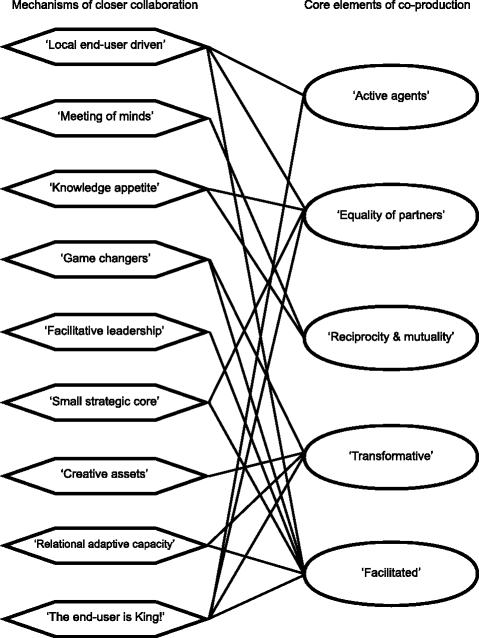Collaborative research and the co-production of knowledge for practice: an illustrative case study
- PMID: 26897169
- PMCID: PMC4761144
- DOI: 10.1186/s13012-016-0383-9
Collaborative research and the co-production of knowledge for practice: an illustrative case study
Abstract
Background: In 2008, the National Institute for Health Research (NIHR) began funding a major 5-year pilot research programme of translational research in England, establishing nine 'Collaborations for Leadership in Applied Health Research and Care' (CLAHRCs). A number of evaluations were carried out to examine whether or not the various collaborations worked as intended and why. In this paper, we examine what the theory of co-production adds to understanding of processes of knowledge creation and translation we observed in one of the CLAHRCs.
Methods: A case study of a successful knowledge translation project was identified from our wider realist evaluation of the mechanisms of closer collaboration at play in the CLAHRC. In the project, a computer simulation model of an emergency pathway for acute ischaemic stroke was built to explore if and how the time between the onset and treatment of the condition could be minimised by redesigning the pathway. The aim of the case study was to improve our understanding of the nature and workings of the mechanisms of closer collaboration that were associated with the more successful projects by examining the relevance of the theory of co-production. Qualitative methods of analysis were used to explore the fit between the mechanisms of closer collaboration we observed in the realist evaluation and the principles of co-production we identified from the literature.
Results: We found a close fit between the nine mechanisms of closer collaboration at work in the project and the principles of co-production (active agents; equality of partners; reciprocity and mutuality; transformative; and facilitated). The successful style of collaborative working exemplified by the project was consistent with a strong form of co-production.
Conclusions: In our view, the theory of co-production provides useful insights into what it is about the qualities of collaborative working that inspire the requisite mechanisms for generating knowledge that is translated into practice. The theory provides a potentially useful basis for future knowledge translation programmes and projects in applied health research in a range of contexts.
Figures
References
-
- Treasury HM. A review of UK health research funding: Sir David Cooksey. London: HM Treasury; 2006.
-
- Department of Health (DH) Report of the high level group on clinical effectiveness, chaired by Professor Sir John Tooke. London: DH; 2007.
-
- Baker R, Robertson N, Rogers S, Davies M, Brunskill N, Khunti K, et al. The National Institute of Health Research (NIHR) Collaboration for Leadership in Applied Health Research and Care (CLAHRC) for Leicestershire, Northamptonshire and Rutland (LNR): a programme protocol. Implement Sci. 2009;4:72. doi: 10.1186/1748-5908-4-72. - DOI - PMC - PubMed
-
- Nicholson D. Innovation, health and wealth: accelerating adoption and diffusion in the NHS. London: Department of Health; 2011.
Publication types
MeSH terms
LinkOut - more resources
Full Text Sources
Other Literature Sources
Medical


